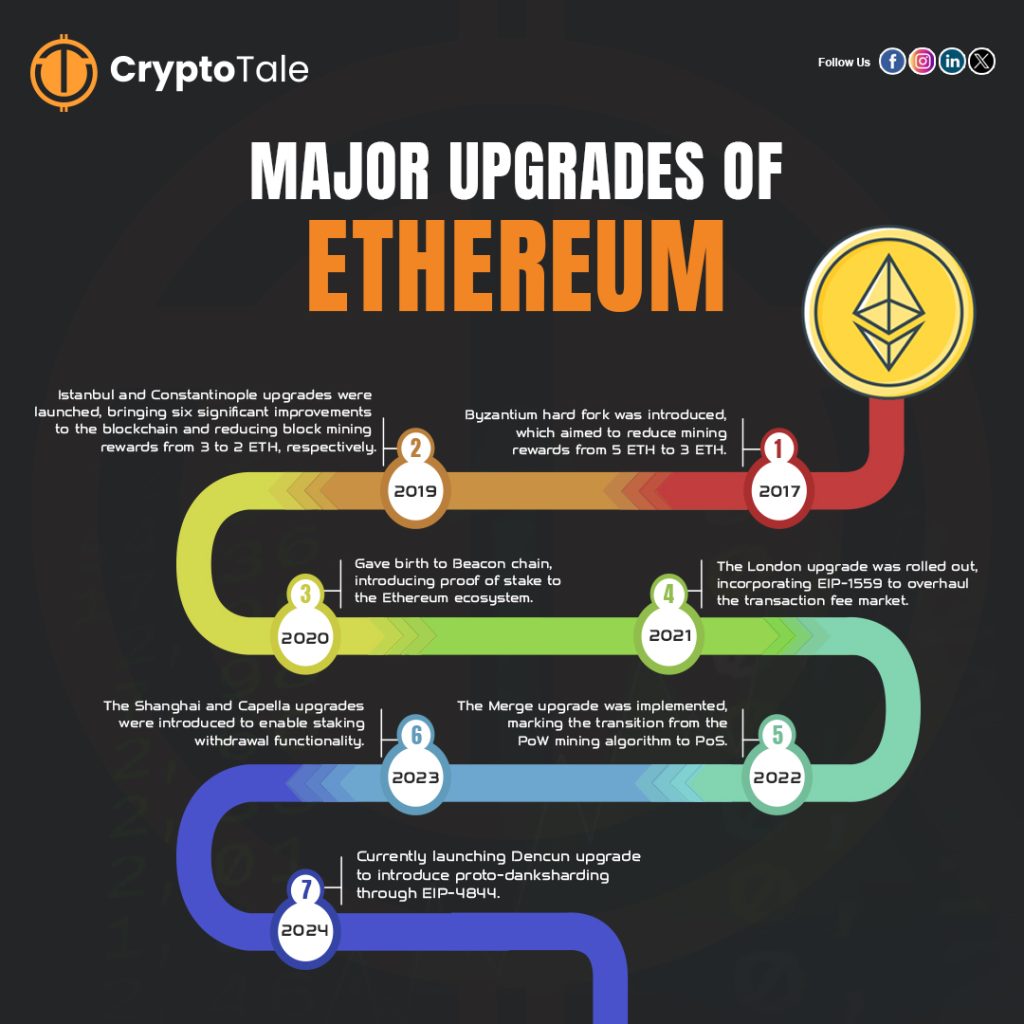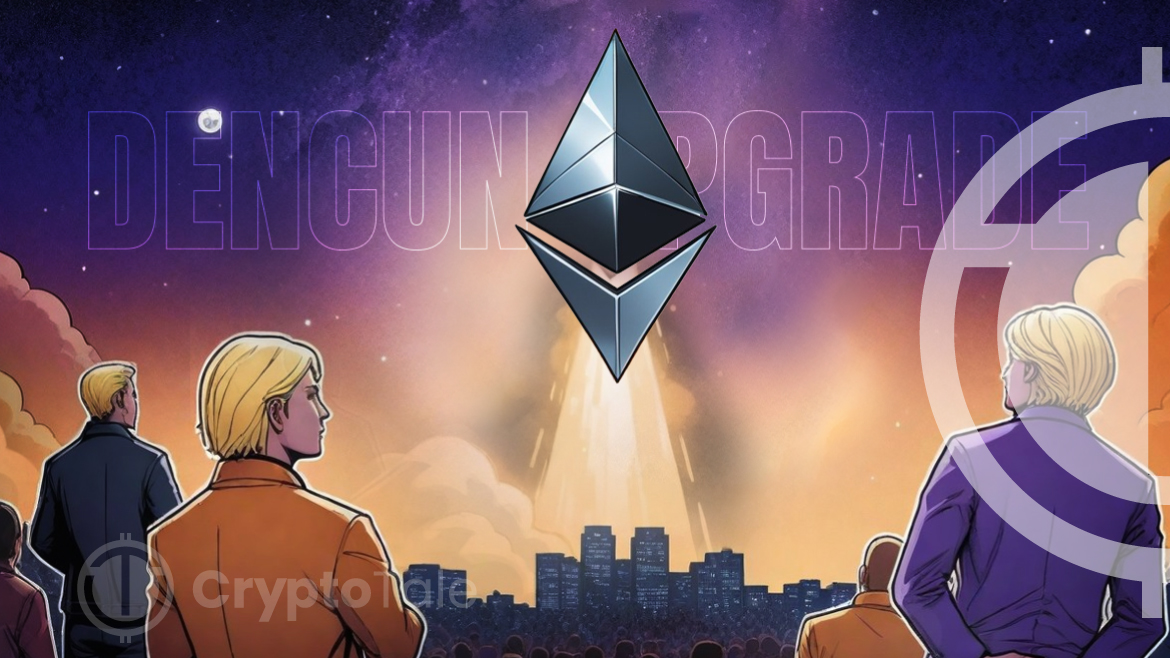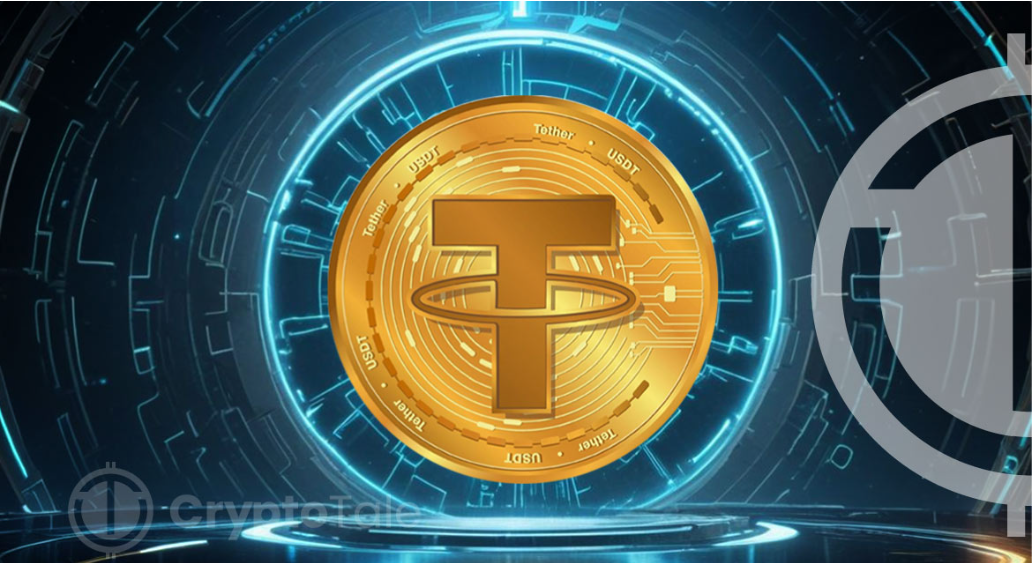Ethereum has always been the forerunner in launching new updates to improve its scalability, security, and sustainability. Recently, Ethereum announced its plan to release the Ethereum mainnet Dencun (Deneb and Cancun) upgrade scheduled for Q1 of 2024. Ever since the Shanghai update, the Cancun upgrade, which is on the horizon, is considered a milestone for the Ethereum network. The Dencun upgrade is much anticipated by the community as it brings the most talked-about “proto-danksharding” feature.
A Brief History of Ethereum’s Upgrade
In 2013, Ethereum’s journey began with Vitalik Buterin’s release of the Ethereum Whitepaper, outlining its unique features enabling smart contracts and decentralized applications (dApps). The platform was officially launched as “Frontier” in July 2015, employing a proof-of-work (PoW) consensus mechanism similar to Bitcoin.
During 2019, Ethereum underwent upgrades named Istanbul and Constantinople, which aimed to refine its gas fee structure and improve scalability. By the close of 2020, Ethereum introduced the Beacon Chain, a proof-of-stake (PoS) blockchain, marking a significant departure from PoW. Eventually, the Beacon Chain supplanted Ethereum’s PoW blockchain in an event termed the Merge.
In September 2022, Ethereum underwent a significant transformation known as the “Ethereum Merge,” marking a pivotal moment in its evolution. This upgrade transitioned the Ethereum network’s mainnet from its original energy-intensive proof-of-work (PoW) consensus mechanism to a more sustainable and efficient proof-of-stake (PoS) model.
However, the Ethereum Merge didn’t initially provide users with the ability to withdraw the Ethereum (ETH) they had staked or the rewards they had earned from their deposits. This limitation left stakeholders unable to access their staked assets or the benefits they had accrued.
Enter the “Shanghai-Capella” upgrade, poised to be the most significant network update since the Ethereum Merge. Scheduled to roll out, this upgrade addresses the crucial issue by enabling users to withdraw their staked ETH, finally granting them access to their deposited assets and the rewards generated through their participation in the network.
Currently, the network is inching closer toward its journey to sustainability and scalability with the Dencun upgrade. It is primarily known for introducing the concept of “blobs,” which enables the storage of data in the mainnet in a more efficient way.

The Current Stage of Dencun Upgrade
The foundation for the Dencun upgrade was laid much earlier in 2022, and initially, it was set to launch in Q4 of 2023. But it was pushed back to 2024 by the developer’s community, citing the technical complexities.
In January 2024, the Dencun successfully underwent the Georli testament despite the bug that happened during the implementation of Prysm. On January 30th, the Dencun upgrade was rolled out in Ethereum’s second testnet, Sepolia, without any hassle. Later, on February 9th, the Holesky test was conducted, and the results were successful. Currently, it is at the final stage of the release and is assured to bring about a major impact on the future of Ethereum.
What Is the Ethereum Cancun-Deneb (Dencun) Upgrade?
The Dencun upgrade is well-known as it brings a series of changes to the execution and consensus layer. It provides a more robust solution for scalability by providing an improved way for smart contracts and dApps.
The Dencun upgrade of Ethereum is one of the most significant changes to be implemented in the second-largest blockchain network. The highly awaited Ethereum hard fork update will introduce proto-danksharding, increasing the scalability and speed of the network. Combining Cancun and Deneb, the upgrade is well known as it applies nine impending EIPs(Ethereum Improvement Proposal).
Ethereum EIPs for Dencun Upgrade
EIPs or Ethereum Improvement Proposals are technical documents or proposed protocols detailing the features to be implemented. These have paved the way for maintaining the network’s decentralization by letting everyone submit proposals. Each upgrade brings a series of EIPs to be implemented, which are bulletin to Ethereum developers. Here is a list of nine EIPs that are going to be introduced along with the Ethereum Dencun upgrade.
1. EIP-1153 – This proposal primarily focuses on reducing the cost of execution of smart contracts by introducing transient storage of opcodes. Through optimization of calculations and a decrease in dependence on permanent storage activities, developers can produce resource-efficient apps that enhance scalability and usability.
2. EIP-4788 – The main application of this proposal is confined to liquid staking and staking. By immediately embedding the parent beacon block root into every execution block, EIP-4788 brings a revolutionary change. By doing this, the Ethereum Virtual Machine (EVM) becomes an oracle that offers access to Ethereum’s consensus state with the least amount of trust.
3. EIP-4844 – It is also called proto-danksharding, which is one of the significant steps in the Ethereum network that introduces a blob-carrying transaction type. As per this innovative proposal, ‘blobs’, which are simpler data units of Ethereum blocks, will be created, providing specific storage space for layer 2 rollups. It could drastically reduce the processing time for each transaction and decrease the gas fee.
4. EIP-5656 – This proposal was made to improve the efficiency while data is being moved to the EVM. As per EIP 5656, a new instruction called MCOPY, or Memory Copying instruction, was added. It is designed to enhance memory copying performance and facilitate more effective data structure construction.
5. EIP-6780 – The goal of EIP 6780 is to change the functionality of the SELFDESTRUCT opcode with zero disruption to smart contracts already using it. The SELFDESTRUCT opcode requires huge storage in the Ethereum state of account as well as the removal of all codes and storage. But this is not futile for the future of the Ethereum network. With the new functionality, the SELFDESTRUCT will not delete any data stored when called for a transaction.
6. EIP-7044 – Signed voluntary exits will be valid forever under EIP-7044, as opposed to just two upgrades—that is, the current and prior consensus layer (CL). With this update, the staking would be made easier and better, especially for those who deploy delegated staking solutions.
7. EIP-7045 – A significant Ethereum update, known as EIP-7045, extends attestation inclusion slots for increased speed and security. Attestations can only be included within a limited window at this time; however, EIP-7045 expands that window to allow attestations to remain valid until the end of the subsequent epoch.
8. EIP-7514 – By capping the per-epoch churn limit at 8, EIP-7514 will make the maximum growth rate of Ethereum validators linear instead of exponential. This proposal is intended to slow down the expansion of the validator set. It is desirable because an excessive number of active validators might induce state-size bloat, which increases the burden on individual nodes as they attempt to stay in sync with one another. The implementation of EIP-7514 would allow the community time to come to a consensus on more comprehensive solutions and to conduct research into them.
9. EIP-7516 – This EIP was proposed to enhance the trustability of the chain by introducing BLOBBASEFEE instruction. It automatically returns the value of the blob base-fee of the current block for the executing transaction to the smart contract. The base fee is the threshold price for a transaction to happen below which it would not be processed.
Proto-Danksharding
The Cancun-Daneb upgrade is one of the major changes since the Shapella release into the Ethereum network. It could enable transactions to happen off the main chain and verify it in a cost-effective way. This was made possible with a series of EIPs that are going to be implemented, and the most notable proposal is EIP 4844 or Proto-Danksharking.
The Proto-Danksharding, or EIP 4844, was introduced to solve one of the key challenges encountered by the Ethereum network. The modifications that are going to happen with the Proto-Danksharding will improve the user experience by facilitating the Blockchain to process a higher volume of transactions and smart contracts.
Danksharding is a technique wherein a block is divided into smaller and more manageable portions called “blobs.” with one proposer. The block builders are responsible for selecting the data and transactions that will go into each slot in a block.
The word Proto-Danksharding was coined after an Ethereum researcher Proto Lambda. In the Proto-Danksharding the concept of blobs was introduced and was made relevant to smart contracts. The proposal is capable of reducing transaction costs in Layer 2 protocols.
With the implementation of Danksharding and Proto-danksharding, Ethereum can step closer to its long-term goal of scalability and sustainability. By increasing the efficiency of the network, it is set to propel Ethereum to new heights.
How the Dencun upgrade will benefit investors and traders?
Ethereum works with a vision to enhance the user experience to benefit investors in all possible ways. The Dencun upgrade could bring major changes that positively impact ETH investors. Here are some of the advantages for investors.
Enhanced Scalability
The primary feature of the upgrade is to enhance the scalability of the network. This update has the potential to enhance the overall user experience by enhancing transaction throughput while decreasing congestion. As a consequence, ETH investors may profit from quicker and more efficient transactions, which will increase the token’s liquidity and utility.
Reduced Fee
WIth the introduction of several EIPs and new instructions, the upgrade could reduce the transaction fee and make it more efficient. This fee decrease may help investors who often conduct transactions, such as trading and decentralized application interactions.
Network Security and Stability
The Dencun upgrade could provide a more robust Ethereum ecosystem for investors that is highly secured and stable. It would eliminate the bugs associated with a system and make is more secure, establishing trust among the ETH investors.
The Impact of Ethereum Dencun Upgrade
Ethereum has set new standards with constant upgrades and has been the most preferable network. It was evident with Uniswap’s announcement to launch v4 post the Dencun upgrade on Ethereum. Currently, in the “Code Freeze” phase, the firm is working on core code completion, testing, gas fees, security upgrades, and finalizing the rest. This method demonstrates their dedication to offering extensively verified code ever released on Ethereum’.
Also, the Ethereum ETF is on the horizon, which could cause the network activity to peak and make Ethereum reach its period of zenith. It has also received support from Coinbase as it reduces the cost of layer 2 roll-ups by 10 to 100x and ushers in a new era.
The developers of Ethereum constantly struggle and bring innovative solutions to reduce the cost of transactions. The Dencun upgrade is known for boosting transaction efficiency and reducing cost. The hype surrounding the upgrade is being reflected in a surge in network activity and price highs. The recent growth of the network serves as proof of the market’s excitement for the new upgrade.












